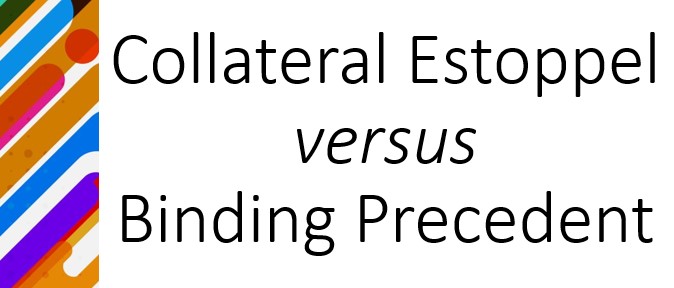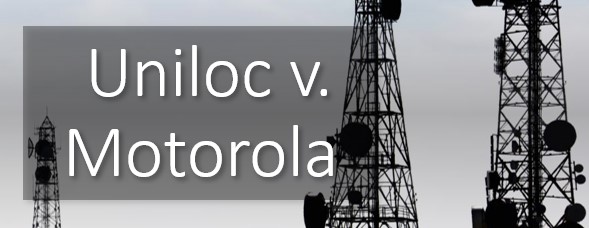Collateral Estoppel Beats Precedent Every Time

by Dennis Crouch
I like to feel of collateral estoppel together with binding precedent. Equally include a set of (at least) two independent conditions, and the problem is usually whether some conclusion drawn in the previously motion forecloses relitigation of exact same (or equivalent) challenge in the latter motion. Precedent is broader because it applies across-the-board irrespective of the functions included. Collateral estoppel (also recognized as situation preclusion) is narrower since it only applies when the celebration staying estopped in the latter motion was also a party in the earlier action. But, when that exact same-occasion need is satisfied, collateral estoppel can be a lot additional impressive.

Most importantly, collateral estoppel has the magical good quality of binding the two horizontally and upwardly. This implies that concerns made the decision at the district or administrative courtroom amount can be binding on all other courts: district courts, administrative courts, appellate courts, and even the Supreme Courtroom. On the other hand, precedent feels the gravitational pull and flows downhill. District court selections are not binding precedent for the reason that they are at the base. The Supreme Court precedent flows down to bind appellate courts whose precedent binds their assigned district courts. While equally the Supreme and Appellate Courts respect their possess prior precedent, it is not binding in the exact same feeling as those courts are also self-empowered to modify their personal precedent. Another essential feature of collateral estoppel is that it applies to each challenges of point and law. Though some courts have disagreed on this place, precedent is only binding for inquiries of legislation.
The Federal Circuit’s recent Uniloc preclusion determination in a hard just one and exemplifies an essential aspect of collateral estoppel power: it is most strident when the unique courtroom final decision is wrongly made the decision, but however binds later courts (such as later on appellate courts). Uniloc United states, Inc. v. Motorola Mobility LLC, 52 F.4th 1340 (Fed. Cir. 2022). Even though the authentic decrease court docket selection violated precedent, it continue to binds the events.

Some history and how this Performed out for Uniloc: HP sold a number of patents to Uniloc again in 2017 who then sued Apple, Motorola, and Blackboard for patent infringement. Uniloc has a litigation funding partnership with Fortress with the patents serving as collateral for the deal. The phrases of the Fortress funding became crucial for the subsequent litigation. Essentially, if Uniloc unsuccessful to meet up with specific revenue targets, Fortress would be specified a license to the patents (which includes a appropriate to sublicense). Uniloc then failed to fulfill the intention, and, by the phrases of the deal, those people license legal rights arguably quickly handed to Fortress.
Just after some venue-action, Uniloc v. Apple ended up prior to Choose Alsup in the Northern District of California. Apple’s lawyers were being able to influence the decide that the license to Fortress meant that Uniloc no more time held whole legal rights to the patent and as a result lacked standing to sue. In my view, Judge Alsup’s conclusion is erroneous on the deserves. A patentee who has non-exclusively accredited its patents even now has standing to sue. Decide Lourie specific the law on this in his “additional-views” while the direct belief basically mentioned that “there is considerable pressure to Uniloc’s argument” on the deserves. Uniloc v. Motorola, 52 F.4th at 1350 (Fed. Cir. 2022). Uniloc appealed the Apple choice and (yet again, in my see) would have likely won on enchantment. . . BUT, the functions achieved a settlement in the midst of appellate briefing and asked the appellate court docket to dismiss the charm. Uniloc did not search for vacatur of the lower court selection as part of the settlement. So, at the end of the day, Uniloc v. Apple finished with district court docket judgment remaining in power, including the selection that the Fortress license left Uniloc with no standing.
The two other instances, Uniloc v. Motorola and Uniloc v. Broadcom, were still pending in D.Del on December 4, 2020 when Choose Alsup issued his dismissal purchase of the Apple situation. Two days afterwards, on December 6, Motorola moved to dismiss on the same floor of lack-of-standing thanks to the license. Oddly, in its briefing Motorola indicated that Apple conclusion was “not binding” but did provide significant authority. I count on that Motorola’s “not binding” remark was an indication of its precedential value somewhat than its preclusive impact. Decide Connolly dismissed the Motorola case, on standing grounds (and with no referring to collateral estoppel). Acting sua sponte, Judge Connolly then dismissed the Broadcom in a short opinion that could have been dependent on challenge preclusion (from the prior Motorola selection), but without the need of truly stating as-such and with out Broadcom earning that assert. One particular base line below, while the events and the court had been all mindful of the prior Apple conclusion, nobody advised at the district courtroom degree that it had issue preclusive impact.
Uniloc appealed the dismissals — arguing that the two choices ended up wrongly interpreted the Constitutional requirements of standing with regard to patent infringement steps. At that stage, the two defendants for the initial time elevated the prospect that Apple had preclusive outcome.
Forfeiture/Waiver: From the set up, you really should be contemplating forfeiture or Waiver. Ordinarily a new protection can’t be lifted for the very first time on charm. Fairly, a party preparing to charm some situation need to first timely increase the difficulty to the district court docket. This rule of appellate treatment applies to the res judicata doctrines of problem and declare precl. Arizona v. California, 530 U.S. 392 (2000) (“res judicata [is] an affirmative protection ordinarily dropped if not timely raised”). Right here even though, we also have the categorical assertion from Motorola that the Apple scenario is “not binding.” That appears to make waiver.
On appeal, the Federal Circuit excused the delay by Motorola and Broadcom and uncovered no forfeiture or waiver. In certain, the court docket pointed out that, even though the Apple conclusion was remaining, it wasn’t final-remaining. For concern preclusion to attach, the authentic motion should be “final,” which commonly implies that the district court docket attained final judgment on all problems in the circumstance. But, the Federal Circuit listed here held that there is no forfeiture unless of course the first circumstance is what I phone last-final–not only reached remaining judgment, but also fatigued all immediate appeals. That further stage is crucial for this situation because the Apple enchantment was still pending as Motorola/Broadcom district courtroom was determining people instances. The Federal Circuit famous “strong plan good reasons supporting a discovering of no forfeiture of collateral estoppel when the argument was to start with lifted after the attractiveness course of action of the preclusive scenario was concluded, and we conclude that forfeiture is not proper here.”
As to waiver dependent on the “not binding” assertion from Motorola, the Federal Circuit concluded that the intent of that assertion was with reference to stare decisis and binding precedent relatively than binding as a subject of preclusion.
Ultimately, the court docket also issued a capture-all statement that–even if there was an unexcused hold off, the courtroom has discretion to excuse the forfeiture. “[W]e have discretion to excuse any forfeiture.” Id. That claim by the courtroom appears to be an overstatement considering that an appellate court docket excusing forfeiture or waiver ought to contemplate the equities of the problem just before going ahead.
Deserves of Difficulty Preclusion: On the deserves, it appears to be to be a quite open up-and-shut situation of difficulty preclusion:
- Similar Concern: The situation of the license and the ensuing no-standing conclusion was litigated made a decision in the initial scenario (Apple) and that exact difficulty is now at issue in the next scenario (Motorola).
- In fact Litigated: The issue was basically litigated in Apple.
- Topic to a Legitimate and Remaining Judgment: The Apple district court docket correctly entered final judgment (and it was not reversed on charm).
- Critical: The license/standing challenge was necessary to the Apple judgment.
Standard collateral estoppel had a same-functions rule, parties in very first circumstance be the very same as all those in the second circumstance. In its 1979 Parklane Hosiery selection, the Supreme Court docket opened the doorway to “nonmutual problem preclusion” that permits non-get-togethers to assert collateral estoppel. The new rule is a very same-celebration rule and is singular instead than plural end result getting that issue preclusion can implement so prolonged as the get together in opposition to whom nonmutual difficulty preclusion is being invoked was a occasion to the former continuing that previously made the decision the exact situation. Listed here, Uniloc was a social gathering to the to start with scenario, and the estoppel is being applied against Uniloc in the second case–so this suits the same-get together rule. Courts distinguish between nonmutual defensive and nonmutual offensive issue preclusion getting much more resistant to making use of concern preclusion in the offensive circumstance. In this article, the preclusion is defensive in nature–Motorola is working with the doctrine to as a protection towards Uniloc’s infringement assert. With all this together, the appellate court effortlessly concluded preclusion applied and hence that the defendants need to quickly win on the situation of standing.
Two areas of this case make me not comfortable. The initial section is an fundamental function of difficulty preclusion — that occasionally the to start with courtroom reaches the improper reply, and problem preclusion can however implement. Below, the improper-answer is amped-up due to the fact it is a Constitutional final decision stripping the plaintiff of standing. Second, and perhaps a lot more importantly is that the appellate court docket skips over a core rule that prohibits the application of collateral estoppel to operate an injustice. In its view, the Federal Circuit consistently cited Wright & Miller, but skipped that full portion of the treatise. Right here, the seeming mistake by Uniloc was settling the Apple charm. Of study course, that was a world-wide dispute involving plenty of other patents. But, by the time of the Apple settlement, the Delaware court had previously issued its conclusions in the two later on conditions and, inspite of a complete opportunity, nothing in any of those instances prompt that the Apple district court decision would have a collateral estoppel effects. It is not very clear to me that these criteria are plenty of to flip the final result, but it looks that the courtroom should have at least regarded as the troubles.






